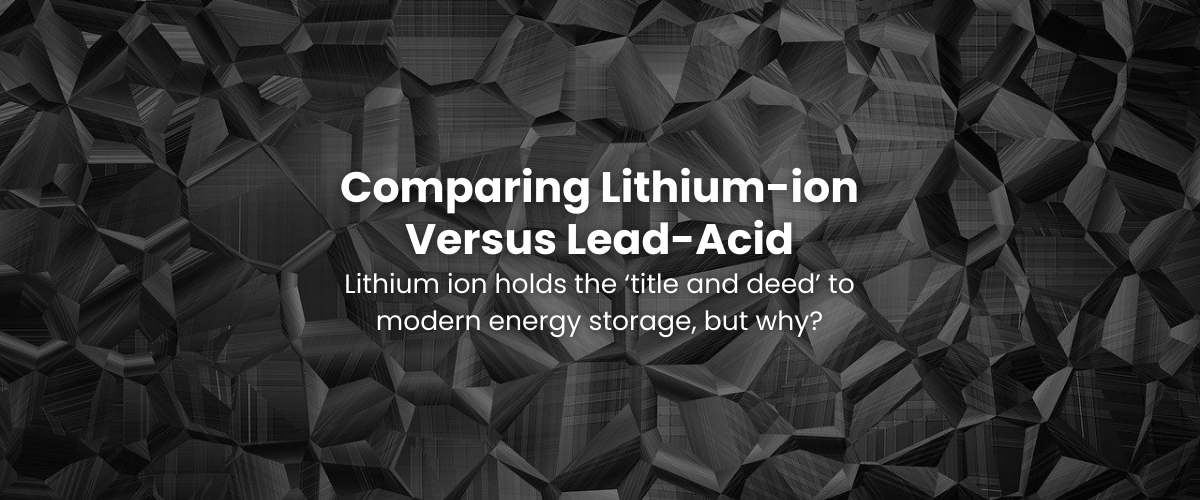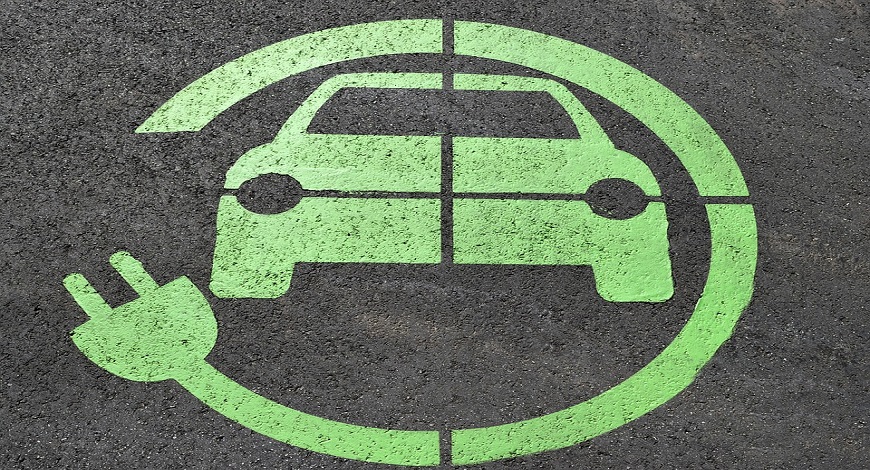The two most common types of battery chemistry that make up the vast majority of the battery waste of today are Lithium-ion batteries and lead-acid batteries. Lithium-ion batteries are made with lithium in combination with other reactive metals like cobalt, manganese, iron, or more, while lead-acid batteries are made with lead and sulfuric acid. The primary differences between these two types of batteries lie in their chemistry, energy density, efficiency, depth of charge, lifespan, and cost.
Lithium ion batteries have become the go-to energy storage technology as of the early 21st Century, and this edition of LOHUM Battery Decoded revisits the key facets of how this worldwide energy storage technology came to become an essential upgrade over the Lead Acid battery.
Lithium-ion vs Lead acid: Key Differentiators
The main differences between lithium-ion vs lead acid batteries lie in their materials, energy density, lifespan, and charging characteristics.
► Lead Acid Battery vs Lithium Ion Battery: Materials
- Lithium-ion: Uses lithium salts in the electrolyte and carbon or lithium compounds for the electrodes.
- Lead-acid: Uses sulfuric acid as the electrolyte and lead and lead oxide for the electrodes.
- Safety of Lithium-ion vs Lead Acid: Lithium-ion batteries are safer than lead acid batteries, as they do not contain corrosive acid and are less prone to leakage, overheating, or explosion.
► Lithium-ion vs Lead Acid: Energy Density
- Lithium-ion: Packs more energy per unit weight and volume, meaning they are lighter and smaller for the same capacity. Think phones, laptops, and electric vehicles.
- Lead-acid: Bulkier and heavier for the same capacity. Used in cars, starting batteries, and off-grid systems.
- Capacity differences in Lithium-ion vs lead acid: A battery’s capacity is a measure of how much energy can be stored (and eventually discharged) by the battery. Although capacity figures can differ based on battery models and brands, lithium-ion battery technology has been extensively tested and shown to possess a considerably higher energy density than lead-acid batteries.
- Energy Efficiency: Lithium-ion batteries are more efficient, losing less energy during charge/discharge cycles. Lithium-ion batteries are highly efficient, with an efficiency rate of 95 percent or more, while lead acid batteries are less efficient, with a rate closer to 80 to 85 percent. High-efficiency batteries charge faster and have a higher effective battery capacity, similar to the depth of discharge.
- Discharge rate: A lead acid battery vs Lithium ion has a slower discharge rate compared to Lithium-ion batteries and has a better storage life. More energy can be discharged faster through Lithium-ion vs lead acid, enabling high-performance electronics of all kinds.
► Lithium-ion vs Lead Acid: Lifespan & Durability
- Lithium-ion: High cycle life, lasting for thousands of charge/discharge cycles before needing replacement.
- Lead-acid: A Lead Acid Battery vs Lithium Ion has a lower cycle life, typically needing replacement after 300-500 cycles. Deep discharge can significantly shorten lifespan.
- Durability & Life: Discharging a battery to power your home or appliances and then recharging it with solar energy or the grid counts as one “cycle.” The longevity of lithium-ion batteries far surpasses that of lead-acid batteries, owing to their superior capacity to endure multiple cycles. This attribute results in an extended effective lifespan of lithium-ion products, which makes them an optimal choice over their lead acid counterparts.
- Maintenance: Lithium-ion batteries require little to no maintenance, while lead-acid batteries need regular electrolyte level checks and topping-up.
► Key Lithium-ion vs Lead Acid: Charging Differences
- Lithium-ion: Lithium-ion vs Lead Acid charges much faster than lead-acid batteries, often taking just a few hours for a full charge.
- Lead-acid: A lead acid battery vs Lithium-ion can take 8-10 hours to fully charge and is prone to damage from fast charging.
- Charging time: Lithium-ion batteries have a shorter charge time than lead-acid batteries and perform better at high temperatures.
► Lithium-ion vs Lead Acid: Environmental Impact
- Environmental impact: Lithium-ion batteries have a higher environmental impact during production, but their longer lifespan and higher efficiency can minimize it over their lifetime. Overall, Lithium-ion batteries vs Lead acid are more environmentally friendly than lead acid batteries, as they do not contain toxic lead and sulfuric acid and can be recycled with greater efficacy.
- Reusability & Circularity: Lithium ion cell modules like those found in Electric Vehicle batteries can be repurposed to make Second life energy storage solutions, capable of augmenting and powering green infrastructure in urban and rural areas alike. Lead-acid batteries are typically ineligible for any kind of repurposing or reuse and must be recycled upon reaching the end of life.
LOHUM is an end-to-end lithium ion battery Extended Producer Responsibility partner under India’s Battery Waste Management Rules (BWMR 2022), pioneering circularity across the energy transition ecosystem and battery value chain.
LOHUM’s NEETM™ hydrometallurgical multi-stage battery recycling and energy transition material refining technology produces some of the highest-grade battery metal salts and Cathode Active Material available in global markets.
Comparing Lithium Ion vs Lead Acid
In terms of performance, lithium-ion batteries tend to perform better and are more efficient than lead-acid batteries Lithium-ion batteries have a longer lifespan than lead-acid batteries.
Comparing the cost of lead-acid and lithium-ion batteries over the past 5 years reveals a dynamic landscape with several key trends:
► Upfront Cost per kWh:
- Lead-acid: While Lead acid vs Lithium ion offers a lower cost per kWh initially, this advantage diminishes over time due to its shorter lifespan and need for replacements.
- Lithium-ion: Although the upfront cost per kWh of Lithium Ion vs Lead Acid is higher, their longer lifespan and higher efficiency translate to a lower total cost of ownership in the long run.
► Estimated Cost Change Over the Past 5 Years:
- Lead-acid: Prices have remained relatively stable, ranging from $50 to $150 per kWh.
- Lithium-ion: Prices have significantly decreased, ranging from $200 to $500 per kWh in 2018 to around $75 to $250 per kWh in 2023.
► Trends:
- The gap in upfront cost between lithium-ion vs lead-acid batteries is narrowing as lithium-ion production becomes more efficient.
- The shift towards renewable energy sources like solar and wind has driven demand for high-capacity, long-lasting batteries, favoring lithium-ion due to its superior performance.
- Investments in research and development are continuously improving lithium-ion technology, further decreasing its cost and environmental impact.
When Did the Move From Lead-Acid Batteries Start, and Why?
While there wasn’t a single defining moment for the “switch” away from lead-acid batteries, the gradual shift towards lithium-ion began around the late 1990s and early 2000s and was driven by several key factors:
► Technological advancements
- Energy density: Lithium-ion batteries offered significantly higher energy density than lead-acid, meaning they could store more energy in a smaller and lighter package. This became crucial for portable electronics like laptops and mobile phones, which craved both power and portability.
- Lifespan: Lithium-ion batteries boast a much longer lifespan, lasting thousands of charge cycles compared to hundreds for lead-acid. This reduced the need for frequent replacements and the associated costs.
- Charging speed: Lithium-ion batteries can be charged much faster than lead-acid batteries, making them more convenient for users.
► Other Contributing Factors
- Government policies: Some countries like Japan and China invested heavily in lithium-ion battery research and development early on, further accelerating their adoption.
- Cost reduction: Although initially expensive, lithium-ion battery production costs gradually decreased with advancements and economies of scale, making them more competitive with lead-acid.
While lead-acid batteries still maintain a strong presence in specific applications like car starting batteries and off-grid systems, their dominance in the overall market began to wane around the aforementioned time frame due to the undeniable advantages offered by lithium-ion technology.
The energy transition is still ongoing, and the future of energy storage seems increasingly inclined towards lithium-ion and its ever-evolving potential. Lead acid battery waste is piling up, constituting a yet larger share of battery waste than Lithium ion as of 2023.
Timeline of the Transition to Lithium Ion Batteries
Lithium-ion batteries didn’t directly cause a single, instant switch from lead-acid batteries. Instead, it was more of a gradual transition that started in the 1990s and continues to this day, with both technologies still holding their own in certain applications.
► Lithium Battery Proliferation Timeline
- 1970s: The first commercial lithium batteries appeared, mainly non-rechargeable types like those used in watches.
- 1985: Akira Yoshino developed the prototype of the modern lithium-ion battery with a safer lithium-ion intercalation compound anode.
- 1991: Sony and Asahi Kasei commercialized the first rechargeable lithium-ion batteries.
- 1990s & Early 2000s: Early adoption of portable electronics like laptops and mobile phones due to their superior energy density, lighter weight, and longer lifespan.
- Mid-2000s onwards: Expansion into power tools, digital cameras, medical devices, and electric vehicles.
- Present day: Lithium-ion continues to displace lead-acid in various applications, but lead acid remains dominant in areas where cost and affordability are critical, like automotive starters and some grid storage.
► Industries at the forefront of the transition to Lithium Ion
- Consumer electronics: Smartphones, laptops, cameras, and other portable devices benefited significantly from the advantages of lithium-ion batteries, leading to smaller, lighter, and longer-lasting gadgets.
- Power tools: Cordless power tools saw a major shift with lithium-ion, allowing for more powerful and efficient tools without the limitations of heavy lead-acid batteries.
- Medical devices: Portable medical equipment like defibrillators, pacemakers, and other healthcare devices thrived with the increased power density and reliability of lithium-ion, improving patient care.
Future Outlook for Lithium-ion vs Lead Acid
- Lithium-ion dominance: Experts predict that lithium-ion will continue to dominate the market in the coming years, potentially reaching 75% share by 2030.
- Lead-acid niche: Lead-acid will likely retain a niche market in applications where its lower cost and established infrastructure remain advantageous, such as some stationary storage applications.
- New technologies: Research into alternative battery technologies like solid-state batteries is progressing, but it might take some time before they significantly impact the market share of existing options.
Regional trends can differ based on factors like infrastructure, adoption rates, and government policies. Market share data can vary depending on the source and specific segment analyzed.
To Conclude
With ongoing advancements and increasing demand for clean energy solutions, lithium-ion seems poised for continued market dominance, while lead-acid will likely adapt to a more focused role in specific applications, and continue to diminish in market share. Overall, the transition from lead-acid to lithium-ion batteries has been a gradual process driven by technological advancements, changing needs, and environmental considerations.
The high energy density and low self-discharge rate of Li-ion batteries made them ideal for portable devices across almost every sector that uses energy. Over time, Li-ion batteries have also found applications in other industries such as automotive, sports, aerospace, and military. Li-ion batteries are now widely used in electric vehicles, hybrid electric vehicles, and plug-in hybrid electric vehicles They are also used in renewable energy systems such as solar and wind power, and grid energy storage.
Stay tuned to the LOHUM blog and our LinkedIn page for updates on the latest developments in battery energy, sustainability, supply chain resilience, energy transition materials, circular economy, Lithium-ion battery recycling, Lithium battery reuse, battery raw material, and more.



